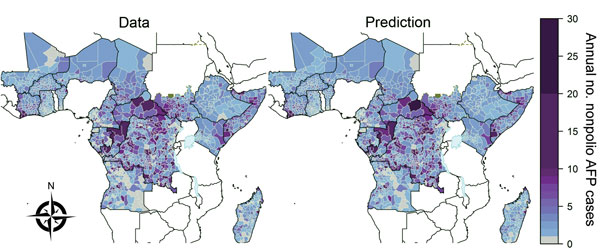Volume 22, Number 3—March 2016
Research
Faster Detection of Poliomyelitis Outbreaks to Support Polio Eradication
Figure 1

Figure 1. Nonpolio acute flaccid paralysis (AFP) cases in sub-Saharan Africa, 2003–2013. Left, mean annual number of cases reported at the second administrative unit (district) in countries in sub-Saharan Africa that have recently experienced a polio importation or outbreak or are considered to be at high risk for these events. Right, expected annual number of nonpolio acute flaccid paralysis cases reported at the district level; the number was obtained by fitting a spatiotemporal mixed-effects regression model to nonpolio AFP data from 2003–2013. Areas that report >25 annual cases are grouped into the 25–30 category (the maximum observed annual reported number was 128 in Tshopo, Democratic Republic of the Congo, in 2007). South Sudan gained independence in 2011, but reporting in this area before independence is shown for comparison. The publication of these maps does not imply the expression of any opinion whatsoever on the part of the World Health Organization (WHO) concerning the legal status of any territory, city, or area or of its authorities or concerning the delimitation of its frontiers or boundaries. WHO does not endorse or approve the use of subnational boundaries in this map. Disputed borders and areas are shown in green and lakes at borders are shown in pale blue.